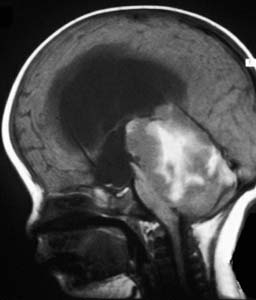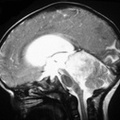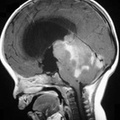
RADIOLOGY: HEAD: Case# 33614: MEDULLOBLASTOMA. This 18 month old child presented with upward deviation of the eyes and somnolence. T1 weighted sagittal MRI reveals a mass in the posterior fossa with areas of high signal intensity. T1 weighted sagital MRI after gadolinium shows mass posterior to the fourth ventricle. There is little change in signal intensity compared to the pre contrast study. T2 weighted axial MRI shows a heterogenous signal mass posterior to the pons. Notice the enlargement of the temporal horns of the lateral ventricles. Medulloblastomas are primarily childhood tumors, where they account for one third of all posterior fossa neoplasms. Medulloblastomas most commonly occur in the cerebellar vermis. In older children and adults they may occur laterally in the cerebellar hemisphere. Imaging studies depict the typical location in the cerebellar vermis, with filling and enlargement of the fourth ventricle. Typically the mass is solid, but cystic changes are not uncommon, especially in the laterally located tumors. Enhancement is variable, but usually moderate and heterogeneous. Medulloblastomas tend to metastasize widely through CSF spread, with CSF dissemination present in up to half the cases at initial surgery. For this reason, the brain and spine should be screened for metastases with contrast enhanced MRI.
- Author
- Peter Anderson
- Posted on
- Thursday 1 August 2013
- Albums
- Visits
- 1865


0 comments